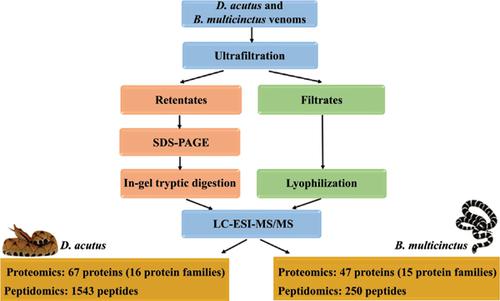Current Proteomics ( IF 0.5 ) Pub Date : 2020-05-31 , DOI: 10.2174/1570164617666191121112319 Yaqiong Zhang 1 , Zhiping Jia 1 , Yunyang Liu 1 , Xinwen Zhou 2 , Yi Kong 1

|
Background: Deinagkistrodon acutus (D. acutus) and Bungarus multicinctus (B. multicinctus) as traditional medicines have been used for hundreds of years in China. The venoms of these two species have strong toxicity on the victims.
Objective: The objective of this study is to reveal the profile of venom proteins and peptides of D. acutus and B. multicinctus.
Methods: Ultrafiltration, SDS-PAGE coupled with in-gel tryptic digestion and Liquid Chromatography- Electrospray Ionization-Tandem Mass Spectrometry (LC-ESI-MS/MS) were used to characterize proteins and peptides of venoms of D. acutus and B. multicinctus.
Results: In the D. acutus venom, 67 proteins (16 protein families) were identified, and snake venom metalloproteinases (SVMPs, 38.0%) and snake venom C-type lectins (snaclecs, 36.7%) were dominated proteins. In the B. multicinctus venom, 47 proteins (15 protein families) were identified, and three-finger toxins (3FTxs, 36.3%) and Kunitz-type Serine Protease Inhibitors (KSPIs, 32.8%) were major components. In addition, both venoms contained small amounts of other proteins, such as Snake Venom Serine Proteinases (SVSPs), Phospholipases A2 (PLA2s), Cysteine-Rich Secreted Proteins (CRISPs), 5'nucleotidases (5'NUCs), Phospholipases B (PLBs), Phosphodiesterases (PDEs), Phospholipase A2 Inhibitors (PLIs), Dipeptidyl Peptidases IV (DPP IVs), L-amino Acid Oxidases (LAAOs) and Angiotensin-Converting Enzymes (ACEs). Each venom also had its unique proteins, Nerve Growth Factors (NGFs) and Hyaluronidases (HYs) in D. acutus, and Cobra Venom Factors (CVFs) in B. multicinctus. In the peptidomics, 1543 and 250 peptides were identified in the venoms of D. acutus and B. multicinctus, respectively. Some peptides showed high similarity with neuropeptides, ACE inhibitory peptides, Bradykinin- Potentiating Peptides (BPPs), LAAOs and movement related peptides.
Conclusion: Characterization of venom proteins and peptides of D. acutus and B. multicinctus will be helpful for the treatment of envenomation and drug discovery.









































 京公网安备 11010802027423号
京公网安备 11010802027423号